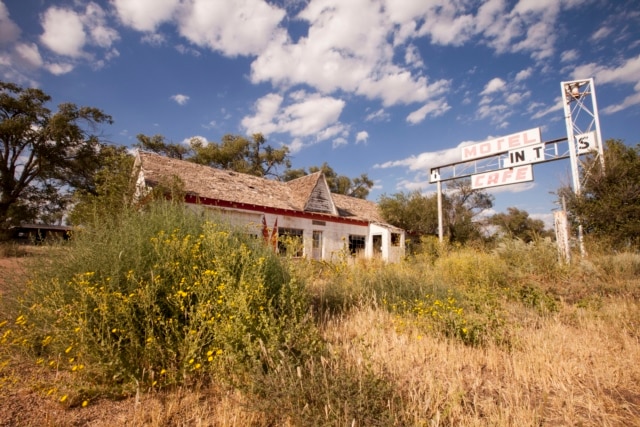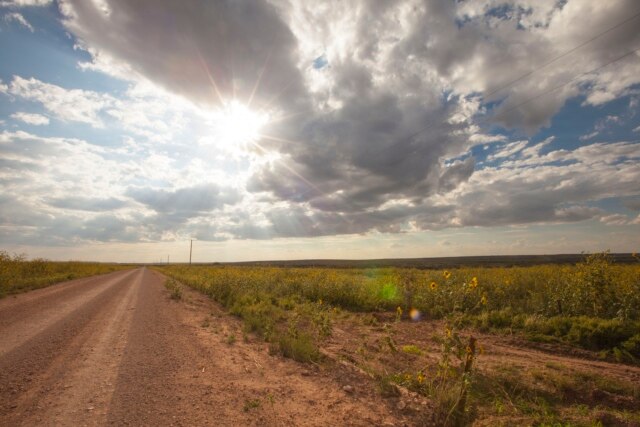The state of New Mexico is called the “Land of Enchantment.” It did not take us long to understand why.
Our first stop in New Mexico was Glenrio. The city itself is now a ghost town. Old motel signs and businesses sit along the Mother Road.
It is a sign of a community passed over once high-speed interstates replaced Route 66. We have seen ghosts town like Glenrio often during our journey west.
The road out of Glenrio is an old part of 66. It winds through stunning fields of sunflowers. The setting sun made for intense color across the land formations and the flowers. It is a very peaceful stretch of the old road. We did not see a single other car for 45 minutes, until Route 66 met up with the highway. For those 45 minutes, it felt like we stepped back in time.

The Blue Swallow motel in Tucumcari, New Mexico is famous for its beautiful sign.
The first major city along Route 66 in New Mexico is Tucumcari. When we arrived, classic motel signs lit up the evening sky. One of the most famous motels along the entire road is Blue Swallow. Its beautiful sign is an international icon for the Mother Road. It truly is enchanting!
From Tucumcari, we started our ascent up to Santa Fe. The New Mexican state capital was bypassed by Route 66 in 1937. The road was rerouted down to Albuquerque. But you can still find reminders of the Mother Road in Santa Fe among old street signs and memorabilia.
Santa Fe is full of history, art and beauty. It is the United States’ oldest capital city, and is home to the country’s oldest church and the oldest house. Visitors can tour both. In the house, visitors get a feel for how Native Americans in the area lived hundreds of years ago.
Nowadays, the city is home to artists from all over the world. On most days, artists fill the city square with small tents offering pieces of art for sale – paintings, jewelry, rugs, pottery and more.
Santa Fe is called the “city different.” It does, indeed, have a different feel than most U.S. cities. Frank McGuire is from Tempe, Arizona. He visits the “city different” often. “The city has a unique blend of cultures. You kind of can find it just roaming the streets here,” he told us.
Santa Fe’s historic adobe architecture style comes from the Pueblo Indians. Adobe is a mix of mud (wet earth) and straw. It becomes very hard when it dries. The city also has beautiful examples of Victorian, Italian, and Spanish buildings.

Bernadine Toya in Santa Fe, New Mexico
Bernadine Toya is from San Felipe Pueblo, an Indian reservation in New Mexico. She often comes to Santa Fe with her husband, who sells his artwork. "It’s very diverse nowadays. And it’s…just very different from reservation life. And it’s very upbeat, nice energy,” she said.
After Santa Fe, we drove to Albuquerque, to meet back up with the more modern-day Route 66. The weather was rainy and gray, but the sky still put on a show. In the early evening, we watched as a rainbow formed over the Mother Road; at night, an electrical storm lit up the land.
Our last stop in New Mexico was Gallup. The small town calls itself the “Native American Capital of the Southwest.” On most nights in the summer, Native Americans perform dances in the city’s center square.
Soon after we left Gallup, the Mother Road crossed into Arizona, our seventh of eight states. We left behind a very enchanting part of our journey.
___________________________________________________________
Words in This Story
enchantment - n. a quality that attracts and holds your attention by being interesting, pretty, etc.
ghost town - n. a town that no longer has any people living in it : an abandoned town
ascent - n. the act or process of rising, moving, or climbing up — usually singular
bypass - v. : to go around an area
memorabilia - n. objects or materials that are collected because they are related to a particular event, person, etc. : things collected as souvenirs
reservation - n. an area of land in the U.S. that is kept separate as a place for Native Americans to live


